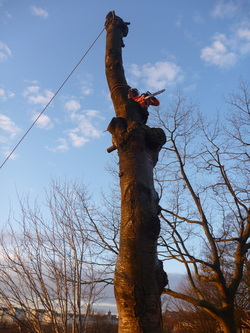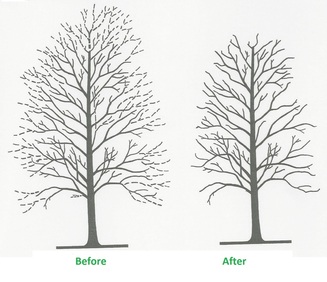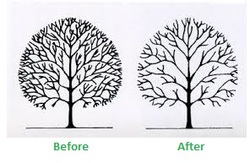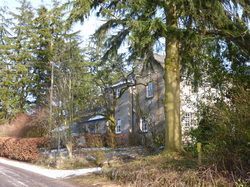Some examples of common arboricultural operations that may solve your tree problems.
Crown ReductionThe pruning of the periphery of the tree canopy, usually carried out to reduce weight, restrict spread of tree or to increase light levels to properties. The diagram above is taken from the current British Standard 3998 and illustrates that the pruning is carried out mostly in the small diameter branch framework and not the through the upright main stem (which is termed “topping” and may be harmful to the tree). In order to conserve the vitality of the tree it is recommended that no more than 30%* of crown volume is removed, however each tree should be assessed individually taking into consideration tree condition and management objectives.
*Due to ambiguity percentages should not be used for tree work specifications during formal applications, with remaining tree dimensions stated instead. |
Crown ThinningThis is the removal of branch's from within the canopy of the tree. It is a great way to allow more light through the tree and can often have a more dramatic effect on available sunlight to a property than crown reduction. Also it creates less wind resistance, and therefore makes the tree less vulnerable to being blown over. However it is essential that this work is carried out by a professional in accordance with BS3998 to avoid 'lions-tailing' - a term used to describe removal of the wrong branch's which actually increases the risk of tree failure.
|
Crown LiftingThe simple pruning of the lowest branch's back to the main stem, handy for increasing clearance from buildings, roads and pedestrians. Also often a good way of increasing light levels to a property. Again, it is important that not too many branch's are removed as this transfers weight up the stem and then makes the tree more susceptible to being blown over
|

Tree Removal
Sometimes trees outgrow their situations, develop structural defects, are in decline, suffer storm damage or are just simply in the wrong place, and complete removal to ground level is the only sensible course of action. The manner in which this is achieved varies greatly depending on obstacles around the tree - from straight felling to technical dismantling and lowering in small sections.


